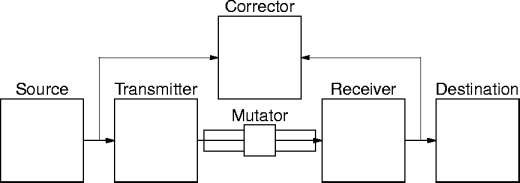Noise and Information Theory
- Noise in information is a corruption of a signal across a communication
channel.
- Noise causes the destination to receive something different from what
was sent by the source.
- Shannon's model is approximately

Noise
- Suppose a source sends a symbol As from the
set S = { A1, A2, ..., Am } and a
destination receives a symbol AR from S.
- Noise can be deterministic or random.
- Deterministic noise always changes As to a specific Ar.
- Random noise changes As to an arbitrary other symbol An.
- Because the message set is known to both sides, messages corrupted
out of the set can be recognized and rejected.
Noise vs. Capacity
- What happens when we communicate over a noisy channel?
- Consider transmitting fair coin flips over a noisy channel.
- The channel mutates 1 bit out of 100 on average.
- The receiver knows, on average, 90% of the messages are correct, but
not which messages are the correct ones.
- What does noise do to the information content of the channel?
Entropy Under Error
- If the source has entropy H(s), what is the entropy at the
receiver?
- With no error it's the same.
- If there is error, how much uncertainty does the medium add?
- Hs(r) is the entropy at the receiver when the source
is message known.
- What is the entropy of the whole system H(s, r)?
- With no noise, H(s, r) = H(s) = H(r).
- With noise, H(s, r) = H(s) + Hs(r) =
H(r) + Hr(s).
Noise and Capacity
- Noise adds extra uncertainty, which reduces the source's information
content.
- The capacity of the channel is reduced by the uncertainty at the
receiver.
C = H(s) - Hr(s)
- The conditional entropy Hr(s) is called equivocation.
- It measures the uncertainty about the symbol received.
Equivocation Example
- To continue the 1 per 100 noisy channel example.
- If the source sends H, the receiver gets a H with p =
0.99 and a T with p = 0.01.
- From the entropy definition
| Hr(s) | = | -0.99 log2 0.99 - 0.01 log2 0.01 |
| = | 0.81 bits/second |
Equivocation and Correction
- The equivocation tells us how much information we have to put into the
system to correct for medium errors.

Equivocation and Communication
- Equivocation can be reduced via redundancy.
- This reduces equivocation, it doesn't eliminate it.
- But doesn't redundancy eat up capacity?
- No, not at the capacity defined previously.
A Discrete Channel with Noise
- Let a source have entropy H and a noisy channel have capacity
C.
- If H <= C, then communication can occur with an arbitrarily
small equivocation.
- If H > C, then communication can occur with arbitrarily small
equivocation not less than H - C.
- In both cases the source has to be encoded to add extra data.
This page last modified on 14 November 2004.


